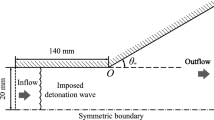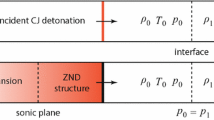Abstract
Results of experimental investigations of an expanding multifront detonation wave are presented. Two stages of spontaneous formation of new disturbances and transverse waves on the expanding detonation‐wave front are observed. The main mechanisms of re‐initiation of detonation waves are discussed. Two‐dimensional numerical simulation of the dynamics of a multifront detonation wave in a linearly expanding channel is performed. The effect of spontaneous formation of new disturbances and new transverse waves is confirmed by computations, and the main mechanism of multiplication of transverse waves is the instability of detonation‐wave‐front elements at the stage they cease to be in the overdriven state and are attenuated during expansion.
Similar content being viewed by others
REFERENCES
A. A. Vasil'ev, Transcritical Gas-Detonation Regimes [in Russian], Novosibirsk (1995).
A. A. Vasil'ev, “Diffraction of multifront detonation,” Combust. Expl. Shock Waves, 24, No. 1, 92–98 (1988).
A. A. Vasil'ev, “Re-initiation upon diffraction of multifront detonation,” Khim. Fiz., 16, No. 9, 107–112 (1997).
A. A. Vasil'ev, “Critical initiation of a gas detonation,” Combust. Expl. Shock Waves, 19, No. 1, 1115–123 (1983).
Ya. K. Troshin and K. I. Shchelkin, Combustion Gas Dynamics [in Russian], Izd. Akad. Nauk SSSR, Moscow (1963).
A. N. Dremin, S. D. Savrov, V. S. Trofimov, and K. K. Shvedov, Detonation Waves in Condensed Media [in Russian], Nauka, Moscow (1970).
V. A. Subbotin, “Collision of transverse detonation waves in gases,” Combust. Expl. Shock Waves, 11, No. 3, 411–414 (1975).
V. A. Subbotin and O. B. Mosunov, “Explosion initiation by mixing of reaction products with an unburned gas,” Dokl. Ross. Akad. Nauk, 328, No. 3, 352–354 (1993).
B. E. Gel'fand, A. N. Polenov, S. M. Frolov, and S. A. Tsyganov, “Occurrence of detonation in a nonuniformly heated gas mixture,” Combust. Expl. Shock Waves, 21, No. 4, 488–492 (1985).
R. Knystautas, J. H. S. Lee, I. O. Moen, and H. G. Wagner, “Direct initiation of spherical detonation by a hot turbulent gas jet,” in: Proc. 17th Symp. (Int.) on Combustion, Pittsburgh (1979), pp. 1235–1245.
V. V. Mitrofanov and R. I. Soloukhin, “Diffraction of a multifront detonation wave,” Dokl. Akad. Nauk SSSR, 159, No. 5, 1003–1006 (1964).
R. Knystautas, J. H. S. Lee, and C. M. Guirao, “The critical tube diameter for detonation failure in hydrocarbon-air mixtures,” Combust. Flame, 48, 63–83 (1982).
A. A. Vasil'ev, A. I. Valishev, V. A. Vasil'ev, and L. V. Panfilova, “Combustion and detonation characteristics of hydrazine and its methyl derivatives,” Combust. Expl. Shock Waves, 36, No. 3, 358–373 (2000).
E. Pantow, M. Fischer, and T. Kratzel, “Detonation front structures in hydrogen combustibles,” in: Conference Proc. 16-ICDERS, Univ. of Mining and Metallurgy AGH, Cracow, Poland (1997), pp. 377–380.
A. V. Trotsyuk, “Numerical simulation of the structure of two-dimensional gaseous detonation of an H2—O2#x2014;Ar mixture,” Combust. Expl. Shock Waves, 35, No. 5, 549–558 (1999).
D. A. Jones, M. Sichel, and E. S. Oran, “Reignition of detonations by reected shocks,” Shock Waves, 5, 47–57 (1995).
E. Pantow, M. Fischer, and T. Kratzel, “Quenching and re-initiation of detonation waves. Modeling and simulation of the phenomena and application for improved detonation arrester design,” in: J.-A. Desideri, C. Hirsch, et al. (eds.), Proc. 3rd ECCOMAS Computational Fluid Dynamics Conference, Paris (1996), pp. 388–393.
M. Fisher, E. Pantow, and T. Kratzel, “Propagation, decay and re-ignition of detonations in technical structures,” in: G. Roy, S. Frolov, K. Kailasanath, and N. Smirnov (eds.), Gaseous and Heterogeneous Detonations. Science to Applications, ENAS Publishers, Moscow (1999), pp. 197–212.
B. Khasainov, C. Priault, H.-N. Presles, and D. Desbordes, “On the mechanism of transition of self-sustained detonation from a tube to a half-space through an annular orifice with central obstacle,” in: 18th Int. Colloquium on the Dynamics of Explosions and Reactive Systems (July 29–August 3, 2001, Seattle), CD ISBN 0-9711740-0-8, No. 096, Univ. Washington, (2001).
A. A. Vasil'ev and A. V. Trotsyuk, “Self-organization of multifront structure in expanding detonation wave,” ibid., No. 001.
T. Fujiwara, A. Takasu, and T. Miyasaka, “Detonation Propagation in Variable Cross Section Channels,” ibid., No. 108.
V. A. Levin and V. P. Korobeinikov, “Strong explosion in a combustible gas mixture,” Izv. Akad. Nauk SSSR, Mekh. Zhidk. Gaza, No. 6, 48–51 (1969).
D. R. White, “Density induction times in very lean mixtures of D2, H2, C2H2, and C2H4 with O2,” in: 11th Symp. (Int.) on Combustion, Berkeley (1966), pp. 147–154.
Yu. A. Nikolaev, “Model of the kinetics of chemical reactions at high temperatures,” Combust. Expl. Shock Waves, 14, No. 4, 468–471 (1978).
Yu. A. Nikolaev and D. V. Zak, “Agreement of models of chemical reactions in gases with the second law of thermodynamics,” Combust. Expl. Shock Waves, 24, No. 4, 461–463 (1988).
S. K. Godunov (ed.), Numerical Solution of Multidimensional Problems of Gas Dynamics [in Russian], Nauka, Moscow (1976).
Yu. A. Nikolaev and P. A. Fomin, “Analysis of equilibrium flows of chemically reacting gases,” Combust. Expl. Shock Waves, 18, No. 1, 53–58 (1982).
Yu. A. Nikolaev and P. A. Fomin, “Approximate equation of kinetics in heterogeneous systems of the gas-condensed-phase type,” Combust. Expl. Shock Waves, 19, No. 6, 731–736 (1983).
S. Yamamoto and H. Daiguji, “Higher-order-accurate upwind schemes for solving the compressible Euler and Navier—Stokes equations,” Comput. Fluids, 22, Nos. 2/3, 259–270 (1993).
H. Daiguji, X. Yuan, and S. Yamamoto, “Stabilization of higher-order high resolution schemes for the compressible Navier—Stokes equation,” Int. J. Numer. Meth. Heat Fluid Flow, 7, Nos. 2/3, 250–274 (1997).
S.-Y. Lin and Y.-S. Chin, “Comparison of higher resolution Euler schemes for aeroacoustic computations,” AIAA J., 33, No. 2, 237–245 (1995).
S. R. Chakravarthy and S. Osher, “A new class of high accuracy TVD schemes for hyperbolic conservation laws,” AIAA Paper No. 85-0363 (1985).
P. Batten, M. A. Leschziner, and U. C. Goldberg, “Average-state Jacobians and implicit methods for compressible viscous and turbulent flows,” J. Comput. Phys., 137, 38–78 (1997).
F. Coquel and B. Perthame, “Relaxation of energy and approximate Riemann solvers for general pressure laws in fluid dynamics,” SIAM J. Numer. Anal., 35, No. 6, 2223–2249 (1998).
Author information
Authors and Affiliations
Rights and permissions
About this article
Cite this article
Vasil'ev, A.A., Trotsyuk, A.V. Experimental Investigation and Numerical Simulation of an Expanding Multifront Detonation Wave. Combustion, Explosion, and Shock Waves 39, 80–90 (2003). https://doi.org/10.1023/A:1022157504636
Issue Date:
DOI: https://doi.org/10.1023/A:1022157504636




